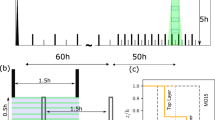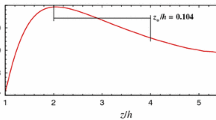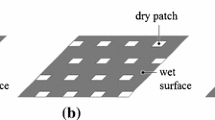Abstract
Recent observations of flux-gradient anomalies in atmospheric flow close to forests, and similar rough surfaces, prompted a wind-tunnel investigation in which cross-wire anemometry was used to study the vertical development and horizontal variability of adiabatic flow over five regularly arrayed rough surfaces, encompassing a 32-fold range of roughness concentration λ. The roughness elements were cylinders, 6 mm in both height and diameter.
Below a layer in which the velocity profile is semi-logarithmic, two surface influences upon the mean velocity field can be distinguished: wake diffusion and horizontal inhomogeneity. The wake diffusion effect causes non-dimensional vertical velocity gradients to be smaller than in the semi-logarithmic region; at least for elements with aspect ratios l/h ≲ 1, it is governed by the transverse dimension l of the roughness elements, and is observed when z > h + 1.5l (where z is height above the underlying surface, and h is the height of the roughness elements). A simple diffusivity model successfully describes the horizontally averaged velocity profiles in the region of wake influence, despite conceptual disadvantages. The horizontal inhomogeneity of the flow is negligible when z > h + D (D being the inter-element spacing), and does not entirely mask the wake diffusion effect except over very sparsely roughened surfaces (λ ≲ 0.02). A criterion for negligibility of both effects, and hence for applicability of conventional turbulent diffusivity theory for momentum, is z > h + 1.5D. These results are compared with atmospheric data, and indicate that wake diffusion may well cause some underestimation of the zero-plane displacement d over typical vegetated surfaces.
Similar content being viewed by others
References
Antonia, R. A. and Luxton, R. E.: 1971, ‘The Response of a Turbulent Boundary Layer to a Step Change in Surface Roughness. Part 1. Smooth to Rough’, J. Fluid Mech. 48, 721–761.
Champagne, F. H., Schleicher, C. A., and Wehrmann, O. H.: 1967, ‘Turbulence Measurements with Inclined Hot Wires, Part 1: Heat Transfer Experiments with Inclined Hot Wire’, J. Fluid Mech. 28, 153–175.
Cowan, I. R.: 1968, ‘Mass, Heat and Momentum Exchange Between Stands of Plants and Their Atmospheric Environment’, Quart. J. Roy. Meteorol. Soc. 94, 318–332.
Ford, E. D.: 1976, ‘The Canopy of a Scots Pine Forest: Description of a Surface of Complex Roughness’, Agric. Meteorol. 17, 9–32.
Garratt, J. R.: 1978, ‘Flux Profile Relations Above Tall Vegetation’, Quart. J. Roy. Meteorol. Soc. 104, 199–212.
Hinze, J. O.: 1959, Turbulence: An Introduction to its Mechanism and Theory, McGraw-Hill, New York, 586pp.
Inoue, E.: 1963, ‘On the Turbulent Structure of Airflow Within Crop Canopies’, J. Meteorol. Soc. Japan 41, 317–326.
Kawatani, T. and Meroney, R. N.: 1970, ‘Turbulence and Wind Speed Characteristics Within a Model Canopy Flow Field’, Agric. Meteorol. 7, 143–158.
Klebanoff, P. S.: 1955, ‘Characteristics of Turbulence in a Boundary Layer with Zero Pressure Gradient’, NACA Annual report No. 1247, 19 pages.
Koloseus, H. J. and Davidian, J.: 1966, ‘Free-Surface Instability Correlations, and Roughness-Concentration Effects on Flow Over Hydrodynamically-Rough Surfaces’, USGS Water Supply paper 1592-CD.
Landsberg, J. J. and James, G. B.: 1971, ‘Wind Profiles in Plant Canopies: Studies on an Analytical Model’, J. Appl. Ecol. 8, 729–741.
Marshall, J. K.: 1971, ‘Drag Measurements in Roughness Arrays of Varying Density and Distribution’, Agric. Meteorol. 8, 269–292.
Millikan, C. B.: 1938, ‘A Critical Discussion of Turbulent Flows in Channels and Circular Pipes’, Proc. 5th Intern. Congr. Appl. Mechn., Cambridge, Mass., pp. 386–392.
Mulhearn, P. J.: 1978, ‘Turbulent Flow over a Periodic Rough Surface’, Phys. Fluids 21, 1113–1115.
Mulhearn, P. J. and Finnigan, J. J.: 1978, ‘Turbulent Flow Over a Very Rough, Random Surface’, Boundary-Layer Meteorol. 15, 109–132.
Oliver, H. R.: 1971, ‘Wind Profiles In and Above a Forest Canopy’, Quart. J. Roy. Meteorol. Soc. 97, 548–553.
O'Loughlin, E. M.: 1965, ‘Resistance to Flow Over Boundaries with Small Roughness Concentrations’, Ph.D. Dissertation, University of Iowa.
O'Loughlin, E. M. and Annambhotla, V. S. S.: 1969, ‘Flow Phenomena Near Rough Boundaries’, J. Hydraul. Res. 7, 231–250.
Plate, E. J. and Quraishi, A. A.: 1965, ‘Modelling of Velocity Distributions Inside and Above Tall Crops’, J. Appl. Meteorol. 4, 400–408.
Raupach, M. R.: 1979, ‘Anomalies in Flux-gradient Relationships over Forest’, Boundary-Layer Meteorol. 16, 467–486.
Raupach, M. R., Stewart, J. B., and Thom, A. S.: 1979, ‘Comments on the Paper ‘Analysis of Flux Profile Relationships above Tall Vegetation ... an Alternative View’ by B. B. Hicks, A. D. Hess and M. L. Weseley (Q. J. 105, 1074–1077)’, Quart. J. Roy. Meteorol. Soc. 105, 1077–1078.
Sadeh, W. Z., Cermak, J. E., and Kawatani, T.: 1971, ‘Flow over High Roughness Elements’, Boundary Layer Meteorol. 1, 321–344.
Schlichting, H.: 1936, ‘Experimentelle Untersuchungen zum Rauhigkeitsproblem’, Ing-Arch. 7, 1–34.
Seginer, I. 1974. ‘Aerodynamic roughness of vegetated surfaces’, Boundary-Layer Meteorol. 5, 383–393.
Tennekes, H.: 1973, ‘Similarity Laws and Scale Relations in Planetary Boundary Layers’, D. A. Haugen (ed.), Workshop on Micrometeorology, American Meteorological Society, pp. 177–216.
Tennekes, H. and Lumley, J. L.: 1972, A First Course in Turbulence, M.I.T. Press, Cambridge, Mass., U.S.A., 300pp.
Thom, A. S.: 1971, ‘Momentum Absorption by Vegetation’, Quart. J. Roy. Meteorol. Soc. 97, 414–428.
Thom, A. S.: 1975, ‘Momentum, Mass and Heat Exchange of Plant Communities’, in J. L. Monteith (ed.), Vegetation and the Atmosphere, Vol. 1, Academic Press, London, pp. 57–109.
Thom, A.S., Stewart, J. B., Oliver, H. R., and Gash, J. H. C.: 1975, ‘Comparison of Aerodynamic and Energy Budget Estimates of Fluxes Over a Pine Forest’, Quart. J. Roy. Meteorol. Soc. 101, 93–105.
Tutu, N. K. and Chevray, R.: 1975, ‘Cross Wire Anemometry in High-Intensity Turbulence’, J. Fluid Mech. 71, 785–800.
Uchijima, Z. and Wright, J. L.: 1964, ‘An Experimental Study of Air Flow in a Corn Plant-Air Layer’, Bull. Nat. Inst. Agric. Sci. (Japan) Ser. A., 11, 19–65.
Wilson, N. R. and Shaw, R. H.: 1977, ‘A Higher-Order Closure Model for Canopy Flow’, J. Appl. Meteorol. 16, 1198–1205.
Wooding, R. A., Bradley, E. F. and Marshall, J. K.: 1973, ‘Drag Due to Regular Arrays of Roughness Elements of Varying Geometry’, Boundary-Layer Meteorol. 5, 285–308.
Author information
Authors and Affiliations
Rights and permissions
About this article
Cite this article
Raupach, M.R., Thom, A.S. & Edwards, I. A wind-tunnel study of turbulent flow close to regularly arrayed rough surfaces. Boundary-Layer Meteorol 18, 373–397 (1980). https://doi.org/10.1007/BF00119495
Received:
Issue Date:
DOI: https://doi.org/10.1007/BF00119495




